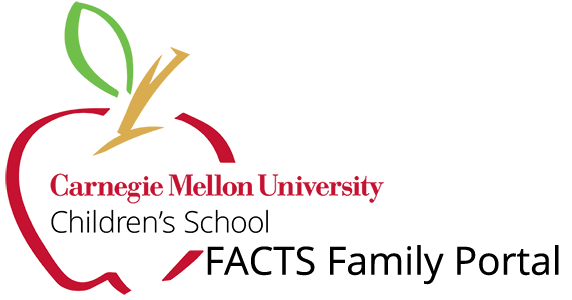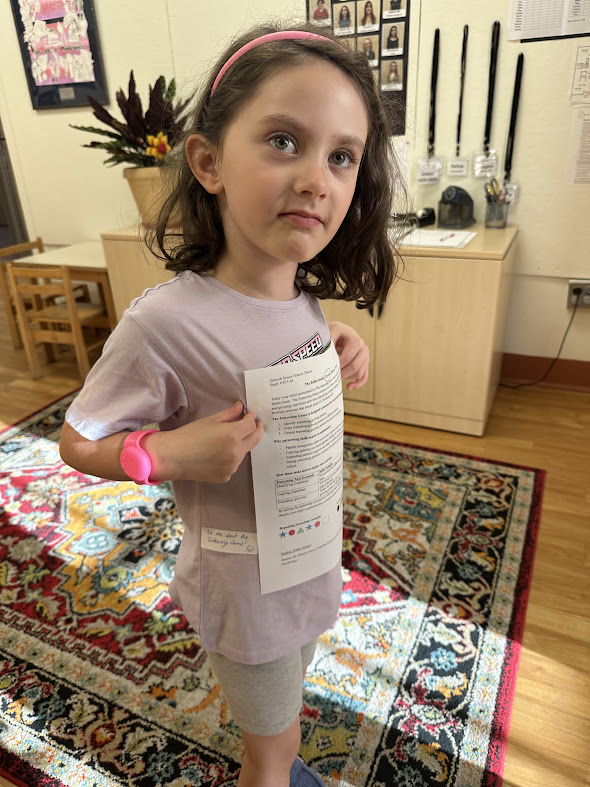Research Spotlight
The Research Spotlight section of the monthly newsletter is one way Children’s School parents can learn about research in progress.
Also, each time your child participates in a study that involves playing a “game” with a researcher (i.e., as opposed to merely being observed), he or she will get a participation sticker suggesting that you, “Ask me about the … game” and a study description detailing the task.
Feel free to contact Dr. Vales to discuss any questions you have about research.
November 2025: Updates from our Lab School Research
In this newsletter I want to share three studies that we are hosting at the Children’s School this semester. If you have any questions about research, please let me (Dr. Vales) know!
Hilary Alonso (an undergraduate honors thesis student working with Dr. Sharon Carver) is doing the Ballet Study with the PreK/Kindergarten classroom. This study is looking at the effects of ballet classes on visual patterning skills. Previous research shows that patterning skills are related to mathematical skills, likely because early math concepts like counting or quantitative reasoning include regularities, rules, and structure. Drawing on her own experience teaching ballet to young children, Hillary wondered whether ballet classes – which expose students to movement patterns – would lead to improvements on visual patterning skills. To make sure that she can attribute any changes on patterning skills to taking ballet classes (rather than, for example, learning patterning skills in the classroom), Hilary needed to have a control group; to ensure that she is not depriving half of the classroom from the potential benefits of the ballet lessons, Hilary is using a very neat study design called “switching replications”. What this means in practice is that Hilary assigned students to receive the ballet classes either in the Fall or the Spring. In the Fall, the students in the “Fall” group receive the ballet classes and the students in the “Spring” group are the control group; then, in the Spring, the groups switch – the “Spring” group receives the ballet classes and the “Fall” group does not. At three time points during the school year, Hilary works individually with students to complete assessments that require identifying, copying, and extending visual patterns. We look forward to seeing what Hilary learns from this study.

Mady Davis-Troller (a Ph.D. student working with Dr. Erik Thiessen) is doing the Relaxing Video and Odd-Fish-Out games with the children for whom we have consent to participate in fNIRS studies. Together with undergraduate student Smrithi Krishnaswamy, the research team is looking at how activity in the frontal cortex is connected to children’s developing executive function skills, like attention and self-control – which undergo marked changes during early childhood. This study has two sessions. In one session, the children wear an appropriately sized fNIRS cap while watching a short calming video (like a moving screensaver); this allows the researchers to record a consistent measure of the brain at rest. The children also play the “Odd Fish Out” game, where they see a row of fish on the screen and are asked to choose the direction the middle fish is facing, while ignoring the directions of the fish on either side. Sometimes the surrounding fish point in the same direction as the middle fish (the easier trials) and sometimes the surrounding fish point in opposite directions (the harder trials, requiring executive functioning). By comparing the two types of trials and relating the responses in the fish game to the fNIRS brain data, the researchers can measure how attention and self-control are supported by the brain’s frontal regions. Mady and her team will continue to work with the children over the school year to better understand how brain connectivity in the frontal cortex changes with age and how everyday experiences relate to growth in early childhood.

 Ricky Choi (a Ph.D. student working with Dr. David Rakison) and two undergraduate students, Marissa Fernandez and Katie Bell, are doing the Mystery Machine study with all classrooms. The researchers are interested in how young children use category membership to make inferences about new information. For instance, imagine that children taste lemon and orange juice mixed together, and the combination tastes sour. Later, they taste lemon juice alone, finding it sour. How will children reason about orange juice afterward? Will they reconsider whether the orange juice contributed to the sour taste of the original mixture, or will they assume all citrus fruits are sour based on category membership?To ensure that children are not using their previous knowledge about categories like fruit, the researchers first teach children new categories in the study by showing them videos of objects belonging either to the same category (having identical internal patterns) or to different categories (each object having a unique pattern). After learning these new categories, the children get to see the three objects interacting with a Mystery Machine, successfully activating it. Then, the children see one object interact with the machine alone – either activating it or not. To understand whether category membership guides children’s inferences, the children are then asked to make guesses about which different combinations of the objects (individual objects, pairs of objects, and all three together) can activate the machine. The answers to these questions will help the research team learn more about how causal reasoning develops between ages 3 and 6, and how category membership shapes this development.
Ricky Choi (a Ph.D. student working with Dr. David Rakison) and two undergraduate students, Marissa Fernandez and Katie Bell, are doing the Mystery Machine study with all classrooms. The researchers are interested in how young children use category membership to make inferences about new information. For instance, imagine that children taste lemon and orange juice mixed together, and the combination tastes sour. Later, they taste lemon juice alone, finding it sour. How will children reason about orange juice afterward? Will they reconsider whether the orange juice contributed to the sour taste of the original mixture, or will they assume all citrus fruits are sour based on category membership?To ensure that children are not using their previous knowledge about categories like fruit, the researchers first teach children new categories in the study by showing them videos of objects belonging either to the same category (having identical internal patterns) or to different categories (each object having a unique pattern). After learning these new categories, the children get to see the three objects interacting with a Mystery Machine, successfully activating it. Then, the children see one object interact with the machine alone – either activating it or not. To understand whether category membership guides children’s inferences, the children are then asked to make guesses about which different combinations of the objects (individual objects, pairs of objects, and all three together) can activate the machine. The answers to these questions will help the research team learn more about how causal reasoning develops between ages 3 and 6, and how category membership shapes this development.
Stay curious!
Dr. Catarina Vales
Research Results
- The Optimal Amount of Visuals Promotes Children’s Comprehension and Attention: An Eye Tracking Study (Cassondra M. Eng, Emma Gurchiek, Kalpa Anjur, Karrie E. Godwin, Anna V. Fisher 2021)
- The Construct and Criterion Validity of a Cognitive Game-based Assessment: Cognitive Control, Academic Achievement, and Prefrontal Cortex Connectivity (Aria Tsegai-Moore, Anna V. Fisher, Cassondra M. Eng 2021)
- Eng, C.M., Godwin, K.E. & Fisher, A.V. (2020) Keep it simple: streamlining book illustrations improves attention and comprehension in beginning readers. npj Sci. Learn. 5, 14.
-
Unger, L, Vales, C., & Fisher, A.V. (2020). The role of co-occurrence statistics in developing semantic knowledge. Cognitive Science, 44, e12894.
- Vales, C., Stevens, P., & Fisher, A.V. (2020). Lumping and Splitting: Developmental changes in the structure of children’s semantic networks. Journal of Experimental Child Psychology.
- Kim, J., Singh, S., Thiessen, E.D., & Fisher, A.V. (2020). A Hidden Markov Model for analyzing eye-Tracking of moving objects: Case study in a Sustained Attention paradigm. Behavior Research Methods.
-
Adaptations of Executive Function and Prefrontal Cortex Connectivity Following Exergame Play in 4- to 5-year old Children (Cassondra M. Eng, Melissa Pocsai, Frank A. Fishburn, Dominic M. Calkosz, Erik D. Thiessen, Anna V. Fisher 2020)
-
The Science of Learning (Ph.D. Dissertation - Karrie E. Godwin, published in Scientific American 2014)
- Using Haptic Inputs to Enrich Story Listening for Young Children (Senior Honors Thesis - Siyan Zhao '14, published in Interaction Design & Children 2015)
- Learning from Number Board Games: You Learn What You Encode (Ph.D. Dissertation - Elida V. Laski, published in Developmental Psychology 2013)
- Improving the Numerical Understanding of Children from Low-Income Families (Faculty Research Robert S. Siegler, published in Child Development Perspectives 2009)
- Names and Object Categories (Faculty Research Anna V. Fisher '07)
- Effect of Coaching on Children's Drawings [Powerpoint Document] (Senior Honor Thesis- Haley A. Vlach '06)





